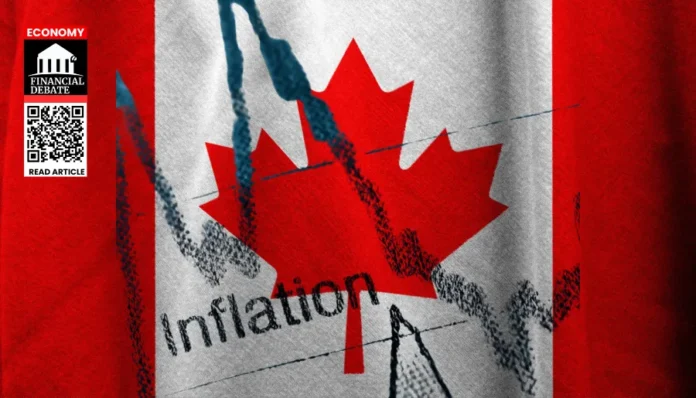- Canada’s inflation rate hit a seven-month low of 1.7% in April, mainly due to lower energy prices.
- Even though overall inflation has decreased, core inflation, which excludes volatile items, has actually gone up.
- The Bank of Canada is watching these trends closely as it decides on future interest rate adjustments.
Canada’s inflation rate experienced a notable decrease in April, falling to 1.7% from 2.3% the previous month. This drop represents the smallest increase in consumer prices in seven months, primarily influenced by a sharp decrease in energy costs. The decline is attributed to the removal of the federal consumer carbon tax and increased oil production by OPEC, leading to significant reductions in gasoline and natural gas prices.
However, beneath the surface of this overall easing, core inflation measures—which exclude volatile items and the impact of the carbon tax—have risen, signaling persistent underlying price pressures within the Canadian economy.
Key Factors Behind the Inflation Drop
The most significant factor contributing to the drop in the annual inflation rate was the substantial decrease in energy prices. Following the removal of the federal consumer carbon tax and a boost in oil output from OPEC nations, energy prices plummeted by 12.7%.
This sharp decline had a cascading effect, most notably on gasoline prices, which fell by 18.1%. Natural gas prices also saw a considerable decrease, dropping by 14.1%. These energy price reductions led to a 1.9% decrease in transportation costs, further contributing to the overall deflationary trend observed in April.
Additionally, the inflation rate for shelter costs also experienced a slowdown, decreasing to 3.4% from 3.9% in March, providing further relief to consumers.
The Rise of Core Inflation
Despite the encouraging decrease in headline inflation, a concerning trend has emerged in core inflation measures. These metrics, which exclude volatile items such as energy and the effects of the carbon tax, provide a clearer picture of underlying price pressures in the economy.
In April, the Bank of Canada’s preferred core inflation indicators, including the CPI median and CPI trim, rose to 3.2% and 3.1%, respectively. These increases mark the highest levels in over a year, indicating that underlying inflationary pressures are not only present but are also intensifying.
Several categories experienced notable price increases, including groceries, which rose from 3.2% to 3.8%, and travel tours, which saw a significant increase of 6.7%. Additionally, household operations, furnishings, and recreation-related expenses also contributed to the upward pressure on core inflation.
The rise in these categories suggests that while some external factors are helping to lower overall inflation, internal economic dynamics are still driving prices higher.
The Bank of Canada’s Response
The latest inflation data comes at a critical time for the Bank of Canada as it prepares for its next interest rate decision on June 4, 2025. In April, the central bank decided to maintain interest rates after implementing seven consecutive cuts, signaling a cautious approach to monetary policy.
However, the bank has also indicated that it remains prepared to take action if inflationary pressures persist. The mixed signals from the April inflation data—a decrease in headline inflation coupled with a rise in core inflation—present a complex challenge for policymakers.
On one hand, the drop in the overall inflation rate provides some relief and could justify a continued pause in rate adjustments. On the other hand, the increase in core inflation suggests that underlying price pressures are still a concern and may warrant a more aggressive monetary policy response.
The Bank of Canada must carefully weigh these competing factors to make an informed decision that supports economic stability while keeping inflation under control.
Expert Opinions and Market Reactions
Economists and market analysts have offered various interpretations of the latest inflation data, reflecting the uncertainty surrounding the economic outlook. Some experts emphasize the positive aspects of the report, highlighting the decrease in headline inflation as a sign that inflationary pressures are easing.
They argue that the drop in energy prices is providing much-needed relief to consumers and businesses, which could help stimulate economic growth. Others focus on the concerning rise in core inflation, warning that it could lead to more persistent inflationary pressures in the long run.
They argue that the Bank of Canada may need to take a more proactive approach to combat inflation, potentially through further interest rate hikes.
The financial markets have also reacted to the inflation data with some volatility. The initial response was positive, with stock markets rising on the expectation that the Bank of Canada may hold off on further rate hikes.
However, as investors digested the details of the report, including the rise in core inflation, concerns about future monetary policy tightening led to some pullback in equity markets. The Canadian dollar also experienced some fluctuations, initially weakening on the lower inflation reading but later recovering as concerns about core inflation emerged.
Looking Ahead
As Canada moves forward, several factors will likely influence the trajectory of inflation. Global economic conditions, including oil prices, supply chain disruptions, and international trade policies, will continue to play a significant role. Domestically, consumer spending, wage growth, and government fiscal policies will also be key determinants of inflation.
The Bank of Canada’s monetary policy decisions will be crucial in managing inflationary pressures and maintaining economic stability. The central bank will need to carefully monitor both headline and core inflation measures, as well as other economic indicators, to make informed decisions about interest rates and other policy tools.
